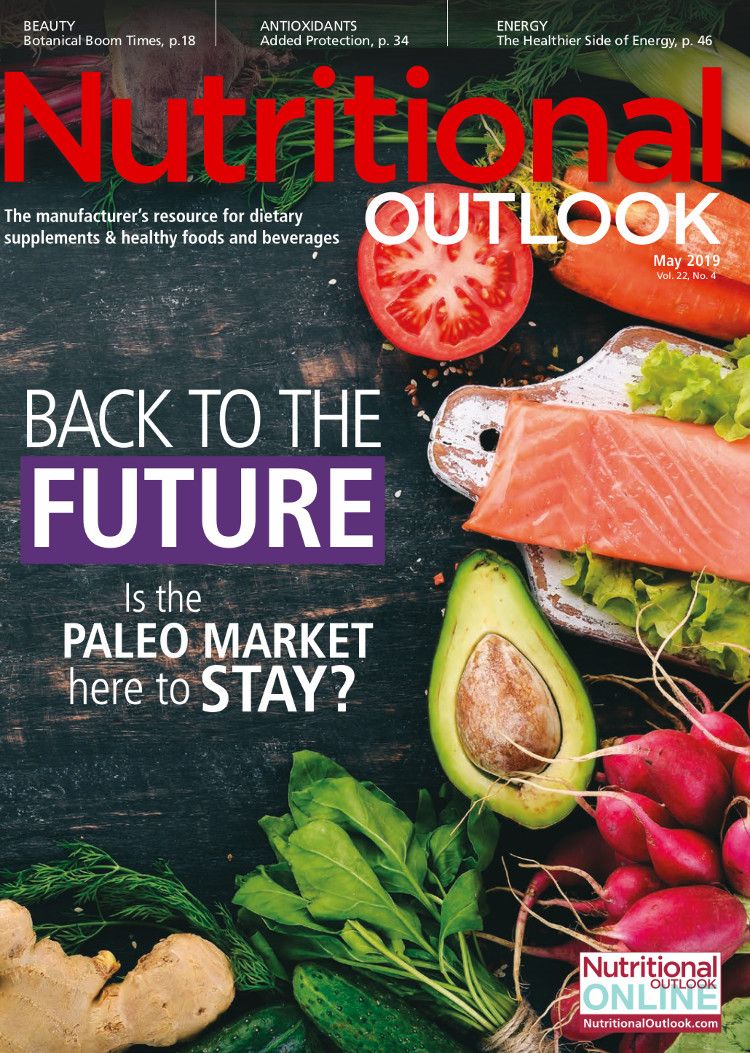Paleo Diet: Is the paleo diet here to stay, or a short-lived trend?
Like the cavemen who inspired the diet, will paleo eventually go extinct?
Photo © AdobeStock.com/Yaruniv-Studio

It’s probably a sign of the strange times we’re in that one of the hottest diet trends to hit supermarkets and social media in years looks not to the future for nutritional solutions, but suggests that we…go back to eating like cavemen.
Yet that’s just what the paleo diet-so-named in a nod to our Paleolithic ancestors-asks its adherents to do. And they’re apparently falling in line, for category analysis from the market research firm SPINS (Chicago) indicates that the $497.6 million market for paleo-positioned products is growing at double-digit rates in all channels the firm follows.
But like the cavemen who inspired the diet, will paleo eventually go extinct? And if it does, will it leave a lasting impact on food and beverage development-to say nothing of how people actually eat-before it goes?
As far as Douglas Smith, co-founder, Paleo Pro Protein Powder and True Nutrition (Vista, CA), is concerned, that would be a fitting legacy. “I really hope the public doesn’t view paleo as a ‘thing’ or something that’s here today, gone tomorrow,” he says. “The idea is to change to this style of eating forever.”
Make Americans Cavemen Again
It’s safe to say that no small contingent of health and nutrition professionals would have a bone to pick with Smith’s idea. For the principles underlying the paleo diet are not without controversy.
Those principles first gained traction-with modern humans, at least-as early as the 1970s. But it wasn’t until the 2002 publication of Loren Cordain’s The Paleo Diet that the eating pattern really caught fire.
That eating pattern rests on the belief that our bodies have yet to evolve to accommodate the foods that agriculture and industrialization have brought. The upshot of this metabolic mismatch, adherents say, has been an epidemic of “diseases of excess” like type 2 diabetes, heart disease, and chronic obesity. By returning to the more pro-adaptive diets of our Paleolithic ancestors, the thinking goes, we’d head off those diseases at the pass.
So permitted within the diet’s pantry are foods like grass-fed meats, fish and seafood, fruit, vegetables, eggs, nuts, and seeds-foods our hunter-gatherer forebears would have, well, hunted or gathered. By contrast, cereal grains and legumes produced through cultivation, dairy products, potatoes, refined sugar, salt, refined vegetable oils, and processed foods more generally are verboten.
“How we see it is that at its core, the paleo diet is the consumption of happy animals and happy plants,” Smith explains-“basically, the foods you’d find before grocery stores were around.”
Beyond that, the “rules” can bend to fit the contemporary caveman’s needs. “Finding what works best for each individual is usually the best step,” Smith advises. “Also, removing foods that reside in the middle sections of the grocery store-the elimination of sugars, grains, lecithin-containing plants, vegetable oils, and essentially anything packaged, boxed, or bagged-is the premise.”
Gathering Mainstream Steam
In a world where convenience commands a premium, selling stretched shoppers on a diet that shuns convenience foods sounds like an uphill battle. But consumers are buying paleo, at least in its broad outlines.
And not just food faddists, either. The SPINS data, which covered natural, specialty gourmet, and conventional multi-outlet retail sales through the 52 weeks ending February 24, 2019, found the fastest paleo growth in the conventional multi-outlet space.
“While the lion’s share of paleo-positioned products are still natural-positioned, conventionally positioned products saw triple-digit growth at a rate of 352.9% over the past year,” notes Michelle Gillespie, NTP, a natural insights analyst with SPINS.
And the reason why, Smith contends, is simple. “The paleo ‘diet’ caught on because it flat-out works,” he says. “If it’s mainstream now, we feel that’s not because it’s a fad, but because it’s how humans should eat. If the public at large moved toward a more paleo-style diet, the metabolic health issues we currently face would dramatically go away.”
How Humans Should Eat?
And that’s where some professional pushback might rear its head.
For despite there being a seductive appeal to the diet’s evolutionary-biological certainty, “[T]he paleo diet concept has been widely criticized for lacking a solid scientific foundation,” notes “Fads in Focus: The ‘Paleo’ Diet,” a May 2016 Euromonitor International opinion paper.
Further, what makes us think that our hunter-gatherer predecessors were so much healthier than we are in the first place? Do we even know what they ate-and in what regions and under what circumstances? And were they even eating that much at all, given the likelihood of periodic famines?
The diet’s tenets also contravene the 2015-2020 Dietary Guidelines for Americans, which explicitly include within their definition of a “healthy diet pattern” paleo-prohibited ingredients like grains-half of which should be whole-pulses, and dairy.
Paying Diverse Dividends
So whether dieting caveman-style really puts us on a path to better health remains debatable. But perhaps paleo followers can tolerate a degree of nutritional dubiousness because the diet pays dividends in a completely different currency that they also value.
For example, notes Gillespie, “Paleo enthusiasts value foods farmed using organic or biodynamic practices, eating in a way they perceive is closer to nature.”
Don’t discount the diet’s fit with a range of contemporary lifestyles, either. “With the widespread popularity of paleo, there are core dieters who span age groups and walks of life,” Gillespie points out. “As the diet moves mainstream, the base of consumers interested in it has grown to encompass everyone from those looking to lose weight to fitness enthusiasts.”
And that helps explain how its influence has spread. A case in point is the keto diet, which Smith thinks has profited from paleo’s popularity. “The ketogenic diet has been around for decades, but it’s begun to really pick up steam,” he claims. Because paleo eating so tightly restricts carb consumption, it “allows the body to start producing ketones from fat and is a really good fit to a ketogenic metabolism.”
A Boon to Bags and Boxes
Given paleo’s celebration of fresh fruits and vegetables, you’d think that the diet’s rising tide would lift produce’s boat, too. But you’d be wrong. According to Euromonitor data published contemporaneously with “Fads in Focus,” fresh vegetable sales in the three markets with the greatest paleo penetration-the U.S., Australia, and the UK-fell, while fresh fruit sales fell in the UK and remained static in the U.S. and Australia.
Indeed, it’s an inescapable irony that the supermarket section best poised to benefit from paleo power may carry the very processed products that the diet so vehemently purports to spurn. Yet the food industry sees the writing on the wall and is fast at work launching new products that, if not paleo per se, are at least “paleo-inspired.”
Consider the 2015 launch in Australia of three new offerings in the free-range meat company Cleaver’s “Paleo Range”: Organic Honey Beef Chipolatas, Chilli Pork Sausages, and Organic Tomato Beef Burgers. As if to leave no doubt that the products are paleo-positioned, “The range’s packaging is graced by a drawing of a spear-wielding caveman,” Euromonitor notes in “Fads in Focus.”
The meat snack movement can also credit paleo for its growing patronage. Euromonitor points to U.S.-based The New Primal as capitalizing on the trend with its Primal Spicy Grass-Fed Beef Jerky and Primal Turkey sticks, the latter made with free-range turkey raised without hormones or antibiotics.
Smith agrees that paleo’s shine has rubbed off on meat-eating. “We seeing much more extreme versions of the paleo diet, like the carnivore diet, which is, essentially, the consumption of meat nose to tail and some animal products-eggs, milk, butter, etc.,” he says. Though it’s about as popular with nutritionists as paleo itself, “It’s picked up quite a bit of energy in the media of late.”
The grain-free trend is another beneficiary of paleo’s success. “While not always low-carb, grain-free products are often higher in protein and lower in refined carbohydrates, giving them appeal to mainstream consumers who may be interested in weight loss,” Gillespie notes. “And products like low-carb cauliflower-crust pizzas entering the mainstream market-even if not entirely grain-free-speak to the influence of paleo on the larger market.”
Some grain-free products are even making paleo palatable. New York City-based Hu Kitchen makes a Get Back to Human Almond Butter + Puffed Quinoa Chocolate Bar that’s both vegan and “primal,” according to the Euromonitor report. And for those wondering how quinoa made it into a “primal” product, it got a pass by qualifying as a seed, not a cereal.
Backlash Brewing
Chocolate bars with almond butter and puffed quinoa probably weren’t what paleo’s progenitors had in mind-either during the Paleolithic era or twenty years ago. And proponents like Smith have mixed emotions about where the eating pattern is headed.
“The fortunate and unfortunate fact is that it’s 2019 and producers are creating products that fit within the paleo lifestyle,” he says. Fortunate because people are catching on, he says; unfortunate in that “many products out there are simply placing a ‘paleo-approved’ sticker on the packaging even though there’s nothing paleo about the product.”
So in another irony for the paleo trend, the backlash to the diet’s success may come from where you’d least expect it: its true believers. “The truth is, I kind of cringe when I hear the term ‘paleo diet,’” Smith admits. “In reality, it should just be the human diet. I’m not sure when we decided that what had been the core human diet for millions of years qualified as a fad, but to consider eating healthy, happy animals and plants a ‘new thing’ is a shame, and somewhat silly.”
Sidebar: Making paleo ingredient sourcing easier
By Jennifer Grebow, Editor-in-Chief
Which ingredients meet the requirements of a paleo diet? One ingredient supplier, Ecuadorian Rainforest (Clifton, NJ), a supplier of all-natural fruit, herb, marine, spice, and vegetable ingredients for the nutraceutical market and specializing in ingredients from South America and beyond, is making it even easier for its clients to determine which ingredients in its portfolio are truly paleo.
Ramon Luna, marketing coordinator, says Ecuadorian Rainforest sees the “massive growth” taking place in the lifestyle diets consumers are now following-namely, keto, paleo, and vegan. The company has identified and is now distinguishing clearly for formulators which ingredients it supplies that meet the needs of each specific diet.
“We want to make sure that manufacturers who are out there looking to address some nutrient holes in those diets know that we can offer ingredients that can help,” says Luna.
Ecuadorian Rainforest offers such popular ingredients as quinoa and flax seed “to round out a paleo diet.” High-fiber nutrients are also helpful in ensuring paleo consumers stay healthy; to this end, the company offers ingredients such as blueberry fiber and raspberry fiber. Other ingredients of paleo interest that the company provides include: 1) cauliflower, which Luna calls a “good source of glucosinolates, a sulfur-containing compound, along with essential fiber” and “a great, low-carb alternative to grains,” 2) avocado (“a great choice for essential fatty acids along with a number of nutrients” and “perfect for a functional paleo beverage,” 3) berries (“Blueberries to strawberries and all the way to raspberry, berries can add antioxidants and also a shot of nutrition to functional foods,” Luna says), and 4) pumpkin seed (“Full of protein, pumpkin seed is a top choice for a paleo-friendly protein formulation while the vitamins make it ideal for a natural multivitamin,” he says.)


.png&w=3840&q=75)

.png&w=3840&q=75)



.png&w=3840&q=75)



.png&w=3840&q=75)


















